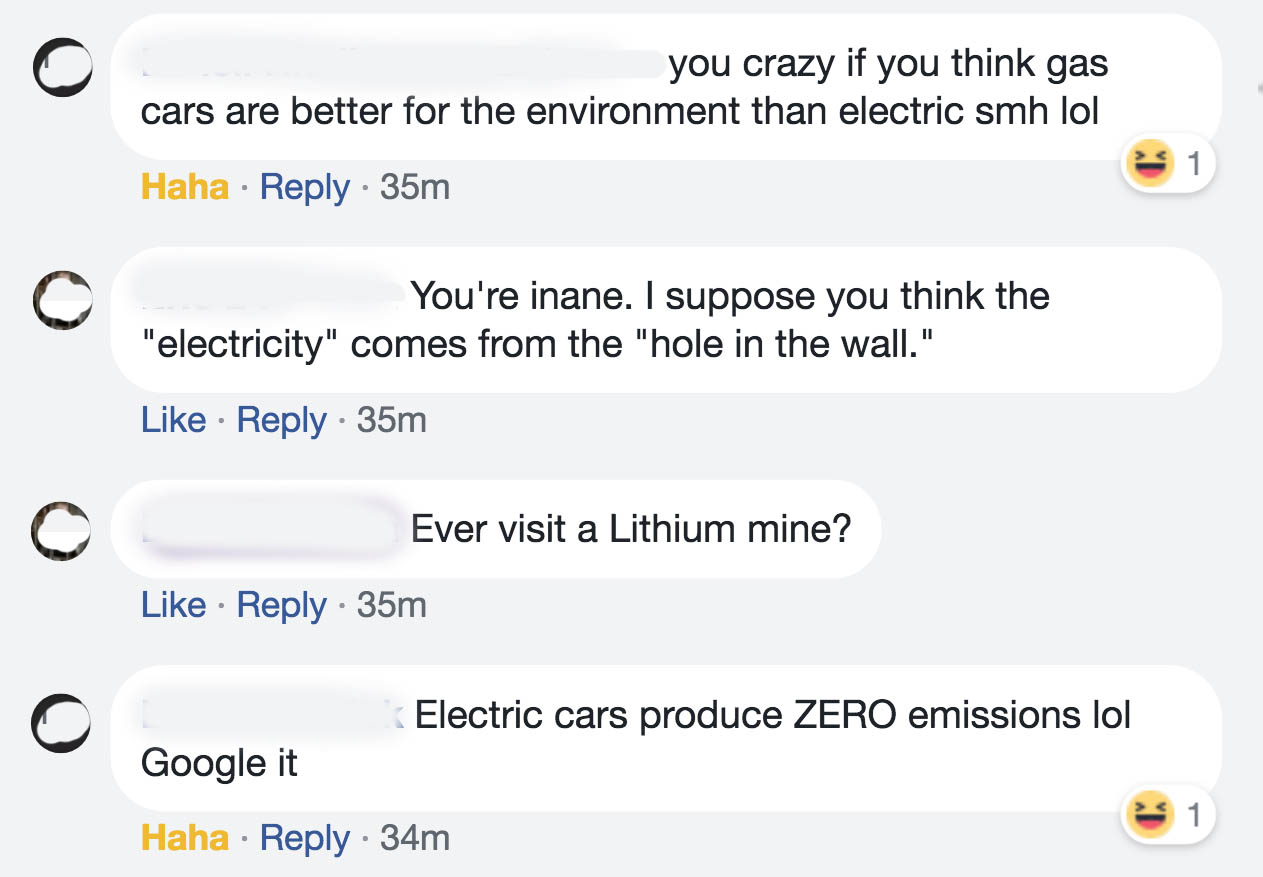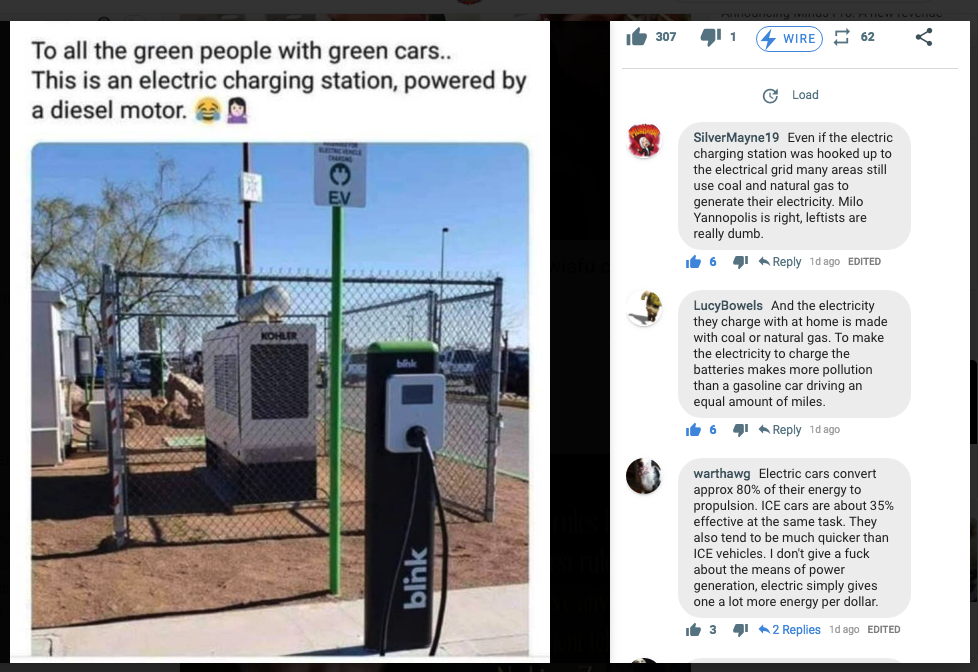May 26, 2018
Updated January 20, 2020
Occupy Democrats Parody
Living in the Silicon Valley in California, there’s no more common a sighting than Tesla and other fun variations on the theme of electric vehicle. There are many factors that make these appealing to the more affluent consumers but the “Zero Emissions” aspect is the biggest badge of honor for those gliding up and down the California highways in whichever of a range of EV’s. These span from the Tesla that appeals to the upper middle class and “rich” down to the less glamorous life of blowing about in a Nissan Leaf.
Tesla dominates in the rich-toy range of “green” machines with sedans and SUV that are as much a delight to drive as they are in amenities, onboard technology, and luxurious appointments.
Most of the lower end options are successfully marketed ONLY by empowering their customers with rights to spend a neighbor’s money (government subsidies and incentives) and of course so-called ZERO EMISSION also earns coveted access to those coveted “car pool” lanes.
So why shouldn’t everyone who can afford one, whether with their own or someone else’s money, be eager to join the electric parade? Well you might have, and certainly may, but I won’t. Here’s why:
1. Lithium Battery Cars are not sustainable.
2. Large application lithium batteries are dangerous
3. Zero Emissions is misleading.
4. Charging Isn’t Really “Free”
5. Cruising range is problematic.
Naturally, at least some of the above 5 concerns may defy conventional common wisdom, so let’s address those sequentially.
1. LITHIUM BATTERY CARS ARE NOT SUSTAINABLE
Let’s assume that plug in electric cars are the real answer and everyone should eventually climb aboard. California legislators are presently even entertaining ideas to ban cars powered by “fossil fuel” from being sold in the State by 2040.
Now let’s assume the liberals proposing electric-plugin as the ultimate “solution” aren’t insane for a moment and explore the next steps to follow through. Lets take for granted that this must be the right answer for us all and convert all auto production to 100% lithium battery plug-ins and see how it works out. And here’s the inconvenient truth. If starting tomorrow every new car manufactured were lithium battery cars, we’d have exhausted the entire Earth’s known lithium reserves in… (pause for dramatic effect…) 30 days! Now what?
What’s more is the cost to environment of making even a hybrid (in fossil fuel costs) isn’t won back until, in most cases after 70k or more miles of driving. When it comes to plug in electric vehicles, there are many environmental costs and the closest thing the Earth has that resembles the lifeless surface of mars is a good lithium mine. Good news is that the lithium can be reclaimed, but there are lots of energy costs associated with getting spent batteries to and from wherever that happens and the energy costs by whatever other source that are incurred in completing those cycles. But, we’re still basically out of lithium, unless Mr. Musk can drive some back from whichever extraterrestrial source he might identify and dispatch his next Tesla launch.
2. LARGE APPLICATION LITHIUM BATTERIES ARE DANGEROUS
We’ve all heard about the dangers of cell phone batteries and people getting serious burns from being too close to one when it flares. These batteries flash with impact, so electric cars of course have all sorts of protection engineered to avoid having a very large flash from a very large bank of lithium battery.
Some may have heard stories where electric car fires move too quickly for passengers to even get out and so like a recent case in Florida with a couple of teenage drivers, they “go down with the ship.” Perhaps that metaphor works better for the recent case in the East Bay where a driver slipped into a small pond and was discovered quite dead the following morning, in this case, more likely from either being trapped and drowned or from the expected result of extremely high voltage meeting lots of water.

With the nature of lithium batteries taken into account, the safety engineering can only be considered impressive, and per Musks’ own calculations you’re 5 times more likely to experience a “vehicle fire” in a ICE (internal combustion engine) powered vehicle, but I remain wary since an electric car fire burns fast, hot, and those extremely difficult fires are far less of an anomaly than Michael Hastings magical exploding Mercedes.

3. ZERO EMISSIONS IS MISLEADING
The same left that subsidizes huge boondoggles like Solyndra, strongly endorse the electric car lifestyle. And of course most will boast that their Tesla or Leaf is absolutely “zero emissions.”

4. CHARGING ISN’T REALLY “FREE”
Now Tesla provides free charging stations so that folks can reload their Tesla (and purportedly other brand of plug-in hybrids too) with no cost out of pocket. Most consumers don’t realize that these costs are accounted for in the price tag of their product and thus, “not savings” and many discover that charging their car where it happens most often is only “free” until you get the power bill. And when the various Tiers 3 and Tier 4 are hit as per the PG&E schemes to rob higher use customer, it’s not quite so much a “savings” as they might have believed.

Many solar panel companies make charging a plug in car part of their pitch to justify the rather high cost of their equipment to mitigate these expenses.
Now when it comes to the “free” charge that you, as a Tesla owner basically “already paid for,” there are some catches there too.
At a mid-point between my own Bay Area living and the popular Los Angeles driving destinations there’s a charging station set up at the Harris Ranch Hotel and Restaurant. The first time I really noticed these I saw a gentleman parked in his Tesla, presumably waiting in line to hook up to begin his charging to continue his trip in whichever direction.
I make a habit of dining on the fine prime rib au jous sandwhich for lunch as a means of breaking a LONG drive into two smaller ones. They also have nice and clean restrooms and a nice little gift shop where I’ll often grab an espresso beverage along with a few little cookies or other snacks. After what amounts to a 60 or 70 minute rest inclusive of all these indulgences I returned to my van, and low and behold! The same dude was sitting there in the same Tesla, and STILL waiting to connect for his “free” charge that had obviously become more expensive if his time is to be taken into consideration.
5. CRUISING RANGE IS PROBLEMATIC
After having leased a Lexus ES 300h, which I absolutely loved, my favorite feature was simply not having to go to a god forsaken gas station the first time until the odometer indicated 500 miles of uninterrupted driving of where I did want to go.
Having driven strictly reliable cars like Honda, Toyota and Lexus, the gas station was about the only stop for “maintenance” in what was otherwise a long run of what was otherwise mostly uninterrupted driving for its own purpose.
I may be unique in my “sensitivity” to maximizing the “go where I want” and minimizing the “go where I don’t” aspect of driving. To my present understanding the plug in electrics (that aren’t hybrid) go nicely as much as 250 miles at highway speeds. That sounds mildly annoying (from my own perspective,) but then I spoke with an owner that reminded me that the cruising range went down sharply whenever his Tesla was driven for its other quality, the joy of amazing and exhilarating acceleration.

Frankly the 200-ish “best case” for ordinary freeway speeds isn’t a point from which to make a tradeoff, so it seems all that “joy” would be limited to quick local sprints after the car is freshly charged on your PG&E tab.

Now all that having been said, electric vehicles like Tesla may have merits. And the technology that goes into them (mainly the dashboard and in self driving) can be appealing to technologists like myself. The present generation cars may also be “practice” for something even more great coming around the corner, so the early adopters may be part of a bigger picture that delivers us to a brighter future.
Tesla batteries are also a way to make homes grid independent or at least able to buy whatever power when the rate is lowest and store plenty from solar panels made relatively cheap by the tier pricing schemes owed to criminally corrupt crony energy entities like PG&E. This writing isn’t to disparage nor pass judgment of any sort against those making, selling nor driving Teslas, Leafs or whatever rolls in between those in the spectrum of “zero emission” choices. And if someone has their own hydroelectric power collection scheme running at a property on a moving body of water, we could even remove the quote marks around “zero emissions.”
I’d only recommend any buyers be as informed as possible about the implication about driving such a vehicle, and whereas one might certainly take some pride in such a splendid toy, being a warrior in the “defending of Earth” is probably not something upon which it can be reasonably based.
Meanwhile I’ll continue to enjoy the Swagger Wagon and Lexus NX. The combined MPG on the former is 176 (per passenger when fully loaded) and the NX is a 4 cylinder turbo that runs efficiently enough for as few as 1.
And whereas I survived my own rough and tumble childhood rolling about in the back of a late 60’s Country Squire Wagon, most all of todays’ choices offer lots more safety and comfort than the 10 passenger wagons of a few years back.
©2018 Occupy Democrats Parody


it feels great to read you again. You have been doing really great job. keep it up..
LikeLike